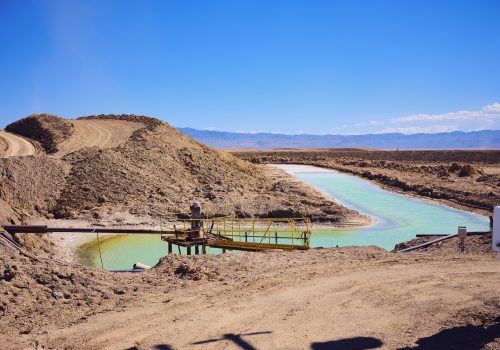September 15, 2023
Planning around strategic supply chains will require more than just ‘listing’ of critical minerals
On Wednesday, September 13, 2023, Reed Blakemore, director of research and programs at the Atlantic Council’s Global Energy Center, testified to the US House Committee on Natural Resources. Below are his prepared remarks for the committee on how the US government should approach increasing global dependence on critical minerals and materials.
Chairman Stauber, Ranking Member Ocasio Cortez, and distinguished members of the Subcommittee, thank you for the invitation to appear before you today.
My name is Reed Blakemore, and I am the director of research and programs at the Atlantic Council’s Global Energy Center, a non-partisan, non-profit foreign policy organization headquartered in Washington, DC. My remarks and written testimony represent my observations, and do not necessarily represent the views of my colleagues or institution.
To summarize my more detailed testimony, I would like to provide a broad overview on our understanding of what makes a mineral critical, and how we should approach a global economy increasingly dependent on an ever-diverse set of minerals and materials.
Why certain minerals and materials are ‘critical’
As many of my colleagues today will reiterate, certain minerals, many of which are supply-constrained, are fundamental to strategically important industries of the United States, such as defense, energy, pharmaceuticals and semiconductors.
Access to these minerals is essential to limiting inflation, global economic leadership, and our national security. The security of supply for such minerals has been strategically relevant to the United States for some time and will continue to be so.
Nonetheless, the rapidly expanding mineral requirements of the energy sector are reshaping how much attention is needed to secure these supply chains.
As clean energy deployment accelerates, our energy technologies will become increasingly dependent on copper, nickel, manganese, graphite, lithium, cobalt, and others. The United States’ total combined clean energy-related demand for lithium, nickel, and cobalt may be twenty-three times higher in 2035 than it was in 2021.
These demands are not only reframing how we think about energy security, but new energy technologies open opportunities for exports and resource security is critical to enabling leadership in emerging sectors such as electric vehicles and renewable power.
The United States is not alone in observing this shift. Allies, partners, peers, and rivals are moving quickly to seize the strategic value of influence in mineral supply chains, exacerbating the geopolitical risk and supply concentration which have long been features of minerals markets.
For instance:
- Through tariffs or export bans, many mineral-rich countries are enacting policies to push investment towards ‘value-added’ economic activities so they can capture the windfall opportunities beyond simply extracting raw materials for export.
- By 2035, it is forecast that as much as 90 percent of all nickel products will be processed by countries that do not hold a free trade agreement with the United States.
- Lastly, China controls 40-to-90 percent of key nodes in the supply chain for rare earth elements, lithium, cobalt, and a host of other minerals critical to the global economy.
The risks of inaction abound.
The characteristics of ‘listmaking’ and increasing importance of relative criticality
This is why a priority of the US government across consecutive administrations has been to identify specific minerals that it deems “critical” and focus policy attention on improving access to or the security of those supply chains.
Deciding which minerals are critical is based on dependency (demand), and the ability to access them reliably (supply). However, with fifty minerals now on at least one of the three formal ‘critical minerals’ lists being produced across the USG, policymakers would do well to think through the relative criticality of minerals that are designated to these lists to mature our strategic planning.
There are a number of mineral-specific factors that apply to this notion, though several stand out as useful first steps for consideration.
On the demand side, these include: the growth rate of demand over time, demand elasticity and substitutability, and differing technology deployment scenarios.
On the supply side, I applaud the critical efforts of the USGS to continue to improve our knowledge of the resource base. Nonetheless, the supply picture is increasingly shaped by additional features, including: Difficult project economics and ore quality declines, lengthy project lifecycles and permitting challenges, and new sourcing methods, like recycling, or waste conversion.
Contextualizing these features is an appreciation for the vulnerability of supply to disruption, namely trade exposure and supply chain concentration.
Provided that the United States cannot supply all its mineral needs domestically, mitigating these supply risks requires work to build trusted supply chain partnerships that limit the possibility of physical interruptions, market imbalances, and government interventions.
This balance defines the space for how we should resolve a particular criticality, which is equally if not more important than ‘listing’ a particular mineral in the first place.
Conclusion
To conclude, there are certain minerals that are structurally important to our national and economic security, and our needs for them are diverse, dynamic, and growing.
Identifying these minerals signifies a need for action and forms the basis for interagency coordination.
But while lists are important, we shouldn’t rely on lists alone. We need to ensure that our minerals policy does not become overly clerkish, prescribing problems rather than solving them.
Capturing the supply/demand dynamism between each critical mineral will illuminate the pathways to build a cohesive minerals strategy.
To be clear, many of the foremost issues in our minerals policy stem from a need for broader reform, be it through permitting or deeper international engagement.
Nonetheless, a properly curated list helps inform decisions on those fronts.
I therefore commend this committee for attention to this issue and look forward to continuing to support its efforts in this area.
Thank you.
Meet the author
Related content
Learn more about the Global Energy Center


The Global Energy Center develops and promotes pragmatic and nonpartisan policy solutions designed to advance global energy security, enhance economic opportunity, and accelerate pathways to net-zero emissions.
Image: The United States Capitol. Unsplash/Chris Grafton




